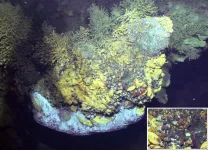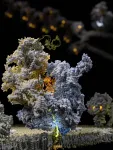Dynamics of nanoparticles using a new isolated lymphatic vessel lumen perfusion system
2021-02-19
(Press-News.org) Nanoparticles used in drug delivery systems, bioimaging, and regenerative medicine migrate from tissues to lymphatic vessels after entering the body, so it is necessary to clarify the interaction between nanoparticles and lymphatic vessels. Although technology to observe the flow of nanoparticles through lymphatic vessels in vivo has been developed, there has been no method to evaluate the flow of nanoparticles in a more detailed and quantitative manner ex vivo. Thus, research was conducted to develop an ex vivo lymphatic vessel lumen perfusion system to determine how nanoparticles move in lymphatic vessels and how they affect the physiological movement of lymphatic vessels.
Nanoparticles introduced into the body enter the lymphatic vessels, which spontaneously contract and dilate to transport lymph fluid throughout the organism. A research group led by Professor Naoto Saito, Director of the Institute for Biomedical Sciences, and Chika Kuroda, a third-year student at Yamaguchi University Faculty of Medicine and Health Sciences and graduate of the Master's Program at Shinshu University Graduate School of Medicine, have developed a new isolated lymphatic vessel lumen perfusion system that can move carbon nanotubes and other nanoparticles into surgically removed lymphatic vessels to visually evaluate their properties. The group succeeded in developing a novel experimental system to evaluate how nanoparticles move in lymphatic vessels and how they affect the physiological movement of lymphatic vessels. The experimental system developed in this study has made it possible to visually and quantitatively elucidate the interaction between nanoparticles and lymphatic vessels and to evaluate the biological safety of nanoparticles.
This is the first time that an ex vivo perfusion system has been created to assess the effects and kinetics of nanoparticles in lymphatic vessels during spontaneous vessel contraction and expansion. Compared with in vivo examinations, the perfusion system permits higher-resolution and more detailed observation of nanomaterial movements along with associated lymphatic vessel reactions. Furthermore, the new system enables both quantitative and histological assessments of a single lymphatic vessel's physiological reaction to nanomaterials. By using this experimental system to evaluate specific nanoparticles, the physiological and histological effects of the nanoparticles on the lymphatic vessels can be clarified, and the clinical application of nanoparticles can be achieved more safely by evaluating their biological safety in combination with cell and animal experiments.
Nanoparticles are considered to be useful options for drug delivery and cancer imaging. After entering the body, they are known to enter lymphatic vessels and accumulate in lymph nodes, although the precise interactions between nanoparticles and lymphatic vessels remain unclear. The new perfusion system enables detailed examinations, safety, and the elucidation of pharmacokinetics for future clinical nanoparticle applications. In the future, the group plans to examine the effects of various nanoparticles on lymphatic vessels depending on their concentration and time with the aim of applying nanoparticles to medicine. In addition, the research group plans to verify the safety of nanoparticles for clinical applications by combining them with cell and animal experiments. Ultimately, they would like to use this system to clinically apply particles whose safety has been confirmed in a wide range of fields such as DDS and imaging, and to elucidate the effects of nanoparticles on the lymphatic system.
INFORMATION:
For complete details, please refer to the published article in Nano Today:
Title: Isolated lymphatic vessel lumen perfusion system for assessing nanomaterial movements and nanomaterial-induced responses in lymphatic vessels
Authors: Chika Kuroda, Kumiko Ajima, Katsuya Ueda, Atsushi Sobajima, Kazushige Yoshida, Takayuki Kamanaka, Jun Sasaki, Haruka Ishida, Hisao Haniu, Masanori Okamoto, Kaoru Aoki, Hiroyuki Kato, and Naoto Saito
Acknowledgements: This work was supported by the Research on Development of New Medical Devices at the Japan Agency for Medical Research and Development (grant 17hk0102021h0003) and JSPS KAKENHI (grant JP16K21065). We are grateful for the help of Professor Toshio Ohhashi of the Department of Innovation of Medical and Health Sciences Research, Shinshu University School of Medicine, Asahi, Matsumoto, Nagano, Japan, along with our many internal and external collaborators.
ELSE PRESS RELEASES FROM THIS DATE:
2021-02-19
A research team led by Prof. QIAN Peiyuan, Head and Chair Professor from the Hong Kong University of Science and Technology (HKUST)'s Department of Ocean Science and David von Hansemann Professor of Science, has published their cutting-edge findings of symbiotic mechanisms of a deep-sea vent snail (Gigantopelta aegis) in the scientific journal Nature Communications. They discovered that Gigantopelta snail houses both sulfur-oxidizing bacteria and methane-oxidizing bacteria inside its esophageal gland cells (part of digestive system) as endosymbionts. By decoding the ...
2021-02-19
A new study looking at how COVID-19 affects people with asthma provides reassurance that having the condition doesn't increase the risk of severe illness or death from the virus.
George Institute for Global Health researchers in Australia analysed data from 57 studies with an overall sample size of 587,280. Almost 350,000 people in the pool had been infected with COVID-19 from Asia, Europe, and North and South America and found they had similar proportions of asthma to the general population.
The results, published in the peer-reviewed END ...
2021-02-19
Researchers at the University of Illinois Chicago have discovered a way to convert the methane in natural gas into liquid methanol at room temperature.
This discovery, reported in the journal Proceedings of the National Academy of Sciences, could potentially provide a cleaner energy source for many of our everyday activities.
When burned, natural gas -- the fuel used to heat homes, cook food and generate electricity -- produces carbon dioxide, a powerful greenhouse gas.
According to the U.S. Energy Information Administration, the U.S. consumed approximately 31 trillion cubic feet of natural gas in 2019, contributing roughly 1.6 gigatons of carbon dioxide to the atmosphere.
A better way to use natural gas would be to convert it to methanol, a liquid fuel that burns more ...
2021-02-19
University of Queensland scientists have developed an ultraviolet 'television' display designed to help researchers better understand how animals see the world.
Until now, standard monitors on devices like televisions or computer screens have been used to display visual stimuli in animal vision studies, but none have been able to test ultraviolet vision - the ability to see wavelengths of light shorter than 400 nanometres.
Dr Samuel Powell, from the Queensland Brain Institute's Marshall lab, said this new technology will help unveil the secrets of sight in all sorts of animals, such as fish, birds and insects.
"Human TVs generally use three colours - red, green and blue - to create images, but our newly-developed ...
2021-02-19
Mitochondria are organelles that act as the powerhouses in our body. They use oxygen which we inhale and food we eat to produce energy that supports our life. This molecular activity is performed by bioenergetic nano-factories incorporated in specialized mitochondrial membranes. The nano-factories consist of proteins cooperatively transporting ions and electrons to generate chemical energy. Those have to be constantly maintained, replaced and duplicated during cell division. To address this, mitochondria have their own bioenergy protein-making machine called the mitoribosome. Given its key role, a deregulation of the mitoribosome can lead to medical disorders such as deafness and diseases including cancer development. The first fundamental understanding of how mitoribosomes ...
2021-02-19
A POSTECH-KAIST joint research team has successfully developed a technique to reach near-unity efficiency of SHEL by using an artificially-designed metasurface.
Professor Junsuk Rho of POSTECH's departments of mechanical engineering and chemical engineering, and Ph.D. candidate Minkyung Kim and Dr. Dasol Lee of Department of Mechanical Engineering in collaboration with Professor Bumki Min and Hyukjoon Cho of the Department of Mechanical Engineering at KAIST have together proposed a technique to enhance the SHEL with near 100% efficiency using an anisotropic metasurface. For this, the joint research team designed a metasurface that transmits most ...
2021-02-19
Photo and map
Robotic laboratories on the bottom of Lake Erie have revealed that the muddy sediments there release nearly as much of the nutrient phosphorus into the surrounding waters as enters the lake's central basin each year from rivers and their tributaries.
Excessive phosphorus, largely from agricultural sources, contributes to the annual summer cyanobacteria bloom that plagues Lake Erie's western basin and the central basin's annual "dead zone," an oxygen-starved region that blankets several thousand square miles of lake bottom and that reduces habitat for fish and other organisms.
The release of phosphorus from Lake Erie sediments during periods of low oxygen--a phenomenon known as self-fertilization or internal loading--has been acknowledged since the 1970s. ...
2021-02-19
We are most familiar with the four conventional phases of matter: solid, liquid, gas, and plasma. Changes between two phases, known as phase transitions, are marked by abrupt changes in material properties such as density. In recent decades a wide body of physics research has been devoted to discovering new unconventional phases of matter, which typically emerge at ultra-low temperatures or in specially-structured materials. Exotic "topological" phases exhibit properties that can only change in a quantized (step-wise) manner, making them intrinsically robust against impurities and defects.
In addition to topological ...
2021-02-19
Despite our great progress in understanding various cellular mechanisms over the last decades, many of them remain unclear. Such is the case for exosomes, small vesicles released by cells that contain genetic materials called "RNA" and various proteins. The roles of exosomes are believed to be very varied and important, both for normal bodily functions and also in the spreading of diseases like cancer. However, exosomes are so small that studying them is challenging and calls for costly and time-consuming techniques, such as electron microscopy (EM).
To tackle this issue, a team of undergraduate students from ...
2021-02-19
Scientists have achieved a breakthrough in predicting the behaviour of neurons in large networks operating at the mysterious edge of chaos.
New research from the University of Sussex and Kyoto University outlines a new method capable of analysing the masses of data generated by thousands of individual neurons.
The new framework outperforms previous models in predicting and assessing network properties by more accurately estimating a system's fluctuations with greater sensitivity to parameter changes.
As new technologies allow recording of thousands of neurons from living animals, there is a pressing demand for mathematical tools to study the non-equilibrium, complex dynamics of the high-dimensional ...
LAST 30 PRESS RELEASES:
[Press-News.org] Dynamics of nanoparticles using a new isolated lymphatic vessel lumen perfusion system





